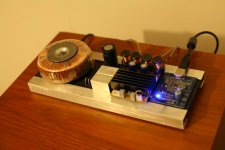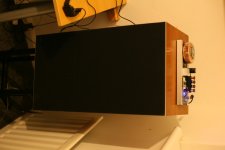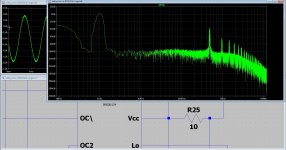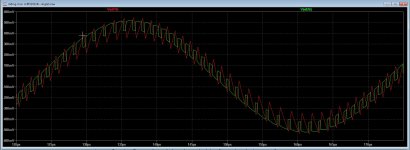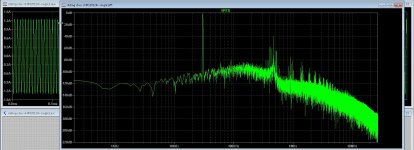I've made a TDA7498 based 100W amp using a USB DAC and a 37V dual winding transformer. I had to replace the chokes to get the heat down but otherwise it is stock.
I have found the amp to have excellent highs and mids but the bass lacks authority. My speakers are B&O 5702's, which are monstrous and easily handle 35Hz.
When I run "speaker-test -t sine -c2 -f 35 -Ddefault:XDA2" I can detect some crosstalk between the channels but it's coming through.
I can purchase two IRS2092 boards, similar in price and design on aliexpress. I don't need the 200W (speakers are 100W max) but given I'm only using the USB DAC an input resistor would handle that. My transformer is a perfect fit as it's dual winding.
Question then, is whether the IRS2092 will give a better sound. I can't find anything comparing the two.
Or perhaps there's a newer alternative? I'm after 100W into 4 ohm and ideally to reuse the transformer, so 37V DC (two windings).
Thanks!
Andrew
I have found the amp to have excellent highs and mids but the bass lacks authority. My speakers are B&O 5702's, which are monstrous and easily handle 35Hz.
When I run "speaker-test -t sine -c2 -f 35 -Ddefault:XDA2" I can detect some crosstalk between the channels but it's coming through.
I can purchase two IRS2092 boards, similar in price and design on aliexpress. I don't need the 200W (speakers are 100W max) but given I'm only using the USB DAC an input resistor would handle that. My transformer is a perfect fit as it's dual winding.
Question then, is whether the IRS2092 will give a better sound. I can't find anything comparing the two.
Or perhaps there's a newer alternative? I'm after 100W into 4 ohm and ideally to reuse the transformer, so 37V DC (two windings).
Thanks!
Andrew
Attachments
On a quick glance my TDA7498 uses a 1uf input capacitor, which starts the bass rolloff quite early. I'll swap them to a bit bigger caps later on so it doesn't bother me now, but maybe yours have similar?
Mine are 1uF too. A couple days ago I was running Q Accoustic 3050 floorstanders and I felt the bass had the same problem, however these could only do 45Hz. At the time I swapped the input capacitors to 2.2uF's but had no difference to bass, in fact I thought it was worse overall so I reverted.
The datasheet specifies 2x 1uF capacitors per channel.
The datasheet specifies 2x 1uF capacitors per channel.
I've made a TDA7498 based 100W amp using a USB DAC and a 37V dual winding transformer.
Can't help with your original question, but wanted to ask you which DAC you used? And how do you like it?
I'm thinking abut doing a similar setup (with different amp), and I'm looking for the right DAC board, that would support at least 24/192 over the USB input... I've been looking at one that looks very similar to yours.
TIA,
Denis
You need to pay attention to the IRS2092 implementation. I've admittedly not listened to the TDA7498 but with my Taobao IRS2092 boards, the power supplies to the chip itself weren't nearly stiff enough being just the internal zeners. Adding substantial decoupling on the OTA rails made a lack-lustre implementation into something worth listening to.
The other thing is the input impedance of IRS2092 boards is low (3k is it, from memory?). You need a buffer with a decent power supply driving this.
The other thing is the input impedance of IRS2092 boards is low (3k is it, from memory?). You need a buffer with a decent power supply driving this.
Can't help with your original question, but wanted to ask you which DAC you used? And how do you like it?
I'm thinking abut doing a similar setup (with different amp), and I'm looking for the right DAC board, that would support at least 24/192 over the USB input... I've been looking at one that looks very similar to yours.
TIA,
Denis
https://www.aliexpress.com/item/SA9...USB-sound-card-decoder-board/32746901075.html
It's only 96KHz though. When do you ever use 96KHz let alone 192? 🙂
Quality is sublime - uses SA9027+ES9023. It will show any deficiencies in the amp though.
It's only 96KHz though. When do you ever use 96KHz let alone 192? 🙂
Quality is sublime - uses SA9027+ES9023. It will show any deficiencies in the amp though.
THX!
Personally, I don't think anything above 24/96 is necessary, but I will be making this for someone else 🙂
Mine are 1uF too. A couple days ago I was running Q Accoustic 3050 floorstanders and I felt the bass had the same problem, however these could only do 45Hz. At the time I swapped the input capacitors to 2.2uF's but had no difference to bass, in fact I thought it was worse overall so I reverted.
The datasheet specifies 2x 1uF capacitors per channel.
The input impedance is fixed at 60k.
Even 470n is big enough for that capacitor.
I have the same problem, bass is bad with the TDA 7498, for as I see it is not such a good chip, the sound is also to bright and lean.
Is class d oke? I think only with multilevel versions with high bandwidth.
Is class d oke? I think only with multilevel versions with high bandwidth.
1. Your lack of bass and sounding lean is a problem of the shitty power supply and lack of filter/sieve capacitors.
2. The TDA 7498 sounds crap, on the multitude of cheap boards it sounds even worse. Get a different amp and PS. Get a different PS first, maybe the SQ is enough for you but a bad PS will make any amp board sound bad. The power supply is the most critical point (and expensive) on any amplifier!
3. The amp class does not provide/grant any information on how good it will sound. There are excellent amps on every possible amplifier class.
4. Tell what you want to do with the amp, otherwise the suggestions will only be guesses and you'll only get random results out of it.
2. The TDA 7498 sounds crap, on the multitude of cheap boards it sounds even worse. Get a different amp and PS. Get a different PS first, maybe the SQ is enough for you but a bad PS will make any amp board sound bad. The power supply is the most critical point (and expensive) on any amplifier!
3. The amp class does not provide/grant any information on how good it will sound. There are excellent amps on every possible amplifier class.
4. Tell what you want to do with the amp, otherwise the suggestions will only be guesses and you'll only get random results out of it.
I have simulate some amps, who I go build.
Waiting now for some converter boards for the chip, to make it possible on experimenting board.
I have replace the tda for a new one and now it is much better, I have however sometimes lean sound and it is because of the bleutooth or the voltage, did change supply for a higher voltage type.
The lowpass filters are special crap here. But is not that a problem, it get used for a old jukebox who is empty and rebuild to nice light and bleutooth speaker for a motorcycle lover his clubhouse so high end is not needed for that music..
in picture inclosed I have done and experiment with a IR20124 chip and later I go also try Gan. The distortion is low, with good deadtime and a bessel 12db low pass who is fase coherent so feedback stays in line as best as possible.
-100 1Khz is quite good, it is a very simple circuit also based on current and postfeedback with low impedance fase shift circuit.. On 20 Khz it is still -80dB HD supression. Ooo and yes, a low pass filter on the input is quite important, just the simplest HF sh*t who get in can give trouble..
Waiting now for some converter boards for the chip, to make it possible on experimenting board.
I have replace the tda for a new one and now it is much better, I have however sometimes lean sound and it is because of the bleutooth or the voltage, did change supply for a higher voltage type.
The lowpass filters are special crap here. But is not that a problem, it get used for a old jukebox who is empty and rebuild to nice light and bleutooth speaker for a motorcycle lover his clubhouse so high end is not needed for that music..
in picture inclosed I have done and experiment with a IR20124 chip and later I go also try Gan. The distortion is low, with good deadtime and a bessel 12db low pass who is fase coherent so feedback stays in line as best as possible.
-100 1Khz is quite good, it is a very simple circuit also based on current and postfeedback with low impedance fase shift circuit.. On 20 Khz it is still -80dB HD supression. Ooo and yes, a low pass filter on the input is quite important, just the simplest HF sh*t who get in can give trouble..
Attachments
Last edited:
Hi,
I was experimenting with LTSpice to simulate the following Analog PWM design from Texas Instruments :
https://www.ti.com/lit/pdf/slau508
I used the closest Analog Devices components, and implemented a voltage controlled voltage source to represent the switching of the output stage, which is fed back, and filtered using an expected filter for a Class D amplifier and 8ohm load.
Using the Hann window for the LTSpice FFT, i do not get the performance you obtain. The 1kHz tone is 3dB down on 0dB, and the 3rd harmonic is at -66dB.
I have modified (not uploaded) the feedback to include a 1st order filter, to reduce this further, but your simulation seems to provide very good performance.
How did you simulate the the class D (i assume you mean IRS20124 MOSFET) and the PWM signal ?
Thanks and regards,
Shadders.
I was experimenting with LTSpice to simulate the following Analog PWM design from Texas Instruments :
https://www.ti.com/lit/pdf/slau508
I used the closest Analog Devices components, and implemented a voltage controlled voltage source to represent the switching of the output stage, which is fed back, and filtered using an expected filter for a Class D amplifier and 8ohm load.
Using the Hann window for the LTSpice FFT, i do not get the performance you obtain. The 1kHz tone is 3dB down on 0dB, and the 3rd harmonic is at -66dB.
I have modified (not uploaded) the feedback to include a 1st order filter, to reduce this further, but your simulation seems to provide very good performance.
How did you simulate the the class D (i assume you mean IRS20124 MOSFET) and the PWM signal ?
Thanks and regards,
Shadders.
Attachments
Hi Shadders
I do use a self oscillating system in slide mode to track the errors through double feedback, current and postfeedback
What you mention is with a clock triangle I do not use.
The IRS20124 is a mosfet driver with build in deadtime setup. I use in simulation the irf6641bpf mosfet.
it is very very simple circuit, looks effective. With Gan I get even below -110dB.
You need to let simulation last until you have a good 1 Khz read, it was not yet there.
I do use a self oscillating system in slide mode to track the errors through double feedback, current and postfeedback
What you mention is with a clock triangle I do not use.
The IRS20124 is a mosfet driver with build in deadtime setup. I use in simulation the irf6641bpf mosfet.
it is very very simple circuit, looks effective. With Gan I get even below -110dB.
You need to let simulation last until you have a good 1 Khz read, it was not yet there.
Hi Kees52,
Thanks for the reply.
Do you have any papers that refer to the self oscillating approach in slide mode ?
For your simulation, how long do you let it run, with step size too ?
Thanks and regards,
Shadders.
Thanks for the reply.
Do you have any papers that refer to the self oscillating approach in slide mode ?
For your simulation, how long do you let it run, with step size too ?
Thanks and regards,
Shadders.
Here you can see slide mode, I have now remove the current feedback and use pre-post feedback, prefeedback from mosfet outputs through a fase shift filter who put out triangle.
Have also other mosfets, now I can reach -90dB on 20 Khz.
(PDF) Design of a Class D Audio Amplifier IC Using Sliding Mode Control and Negative Feedback | angel rojas - Academia.edu
This one use three opamps, I do use just one. one pic let see now on 30 Khz a distortion of -80dB what is nice.
I use bessel 12dB lowpass, it is fase lineair but need 12dB to supress right. a Three level version has more supression because of carrier doubler.
Have also other mosfets, now I can reach -90dB on 20 Khz.
(PDF) Design of a Class D Audio Amplifier IC Using Sliding Mode Control and Negative Feedback | angel rojas - Academia.edu
This one use three opamps, I do use just one. one pic let see now on 30 Khz a distortion of -80dB what is nice.
I use bessel 12dB lowpass, it is fase lineair but need 12dB to supress right. a Three level version has more supression because of carrier doubler.
Attachments
Last edited:
Hi Kees52,
Thanks for this, the LTspice and link to the paper.
Control theory is not something i have studied, so progress will be slow, but the information is useful.
You do seem to be obtaining excellent results in your designs.
Thanks and regards,
Shadders.
Thanks for this, the LTspice and link to the paper.
Control theory is not something i have studied, so progress will be slow, but the information is useful.
You do seem to be obtaining excellent results in your designs.
Thanks and regards,
Shadders.
Last edited:
- Home
- Amplifiers
- Class D
- IRS2092 vs TDA7498 sound quality
